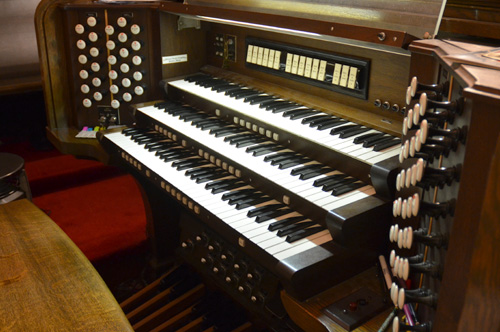Music
Organ
Built during the first half of 1929, Opus 805 of the Skinner Organ Company is an extremely important instrument in the city of Lancaster.
The Boston organ building firm, Skinner Organ Company, and its successor, Aeolian-Skinner have emerged as the foremost names in American organ building from the years 1900 to 1960. In business from 1901 to 1971 the firm produced some 1400 new instruments, as well as hundreds of rebuilding jobs. The late 1920’s was a pivotal period for the firm both tonally and technically. To possess an essentially unaltered example of this period of the firm’s work is a rarity and a privilege.
In 1929, three years after the present Sanctuary of Otterbein Church had been completed, Mrs. Harvey F. Heisey provided for the installation of the pipe organ in memory of her husband. At Mrs. Heisey’s insistence, the foremost builder of the day, Ernest M. Skinner of Boston, was secured for the contract. Dated October 9, 1929, the contract was drawn up just days before the stock market crash, and one wonders whether, had there been a delay in signing, there might not have been an organ at all. This was a fortunate investment and has inspired countless worshippers and musicians ever since. Two dedicatory recitals, played by Carolyn Diller and Harry Sykes, inaugurated the organ in June, 1930.
One of only two E. M. Skinner organs installed in the Lancaster area, the instrument remains essentially unchanged. A new solid-state console was installed by the Gundling Organ Company of Lancaster in 1974, increasing the reliability and flexibility of stop selection. Though of modest size, Otterbein’s instrument is somewhat of a sleeping giant in the Lancaster musical community. A refined example of twentieth-century American organ building, a blessing to its congregation, and to this community. This instrument serves a wide variety of organ repertoire extremely well, not to mention hymns and service accompaniment.
The organ’s tonal design is typical of dozens of smaller Skinner three manuals. There is a sort of mathematical progression to the design ethic, wherein the Swell is always the largest and most complete department, with Great, Choir and Pedal progressively decreasing in numbers of stops. The tonal ideals reflect many tenets of early 20th-century English organ design, in which the Great was intended to provide “diapasons” while the Swell would “run the reeds.” In such a case the Tuba and French Horn would be viewed more as solo stops atop the Great foundation; the Choir voices were entirely subsidiary; the Echo was the olive in the martini.
In 2013 a total console restoration was completed to the organ by Gibson Organ Company and Peterson solid-state electronics installed.

Praise to the Lord, the Almighty
Closing Song
Chancel Choir
The Chancel Choir sings during the church calendar year from mid-September through early June. Members are not required to read music (although it is helpful). High school students and adults are welcome.
Chancel Choir Rehearsal Time
Thursday 7:45 p.m. – 9:00 p.m.
Bell Choir
The Bell Choir plays at least once a month from September through June. It is very helpful for members to read music.
Bell Choir Rehearsal Time
Thursday 6:45 p.m. – 7:30 p.m.
